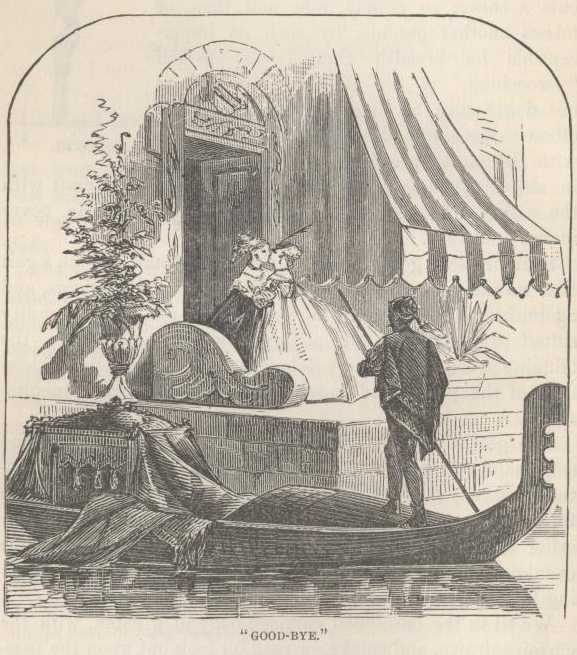The Venetian gondola is as free and graceful, in its gliding movement, as a serpent. It is twenty or thirty feet long, and is narrow and deep, like a canoe; its sharp bow and stern sweep upward from the water like the horns of a crescent with the abruptness of the curve slightly modified.
The bow is ornamented with a steel comb with a battle-ax attachment which threatens to cut passing boats in two occasionally, but never does. The gondola is painted black because in the zenith of Venetian magnificence the gondolas became too gorgeous altogether, and the Senate decreed that all such display must cease, and a solemn, unembellished black be substituted. If the truth were known, it would doubtless appear that rich plebeians grew too prominent in their affectation of patrician show on the Grand Canal, and required a wholesome snubbing. Reverence for the hallowed Past and its traditions keeps the dismal fashion in force now that the compulsion exists no longer. So let it remain. It is the color of mourning. Venice mourns. The stern of the boat is decked over and the gondolier stands there. He uses a single oar--a long blade, of course, for he stands nearly erect. A wooden peg, a foot and a half high, with two slight crooks or curves in one side of it and one in the other, projects above the starboard gunwale. Against that peg the gondolier takes a purchase with his oar, changing it at intervals to the other side of the peg or dropping it into another of the crooks, as the steering of the craft may demand--and how in the world he can back and fill, shoot straight ahead, or flirt suddenly around a corner, and make the oar stay in those insignificant notches, is a problem to me and a never diminishing matter of interest. I am afraid I study the gondolier’s marvelous skill more than I do the sculptured palaces we glide among. He cuts a corner so closely, now and then, or misses another gondola by such an imperceptible hair-breadth that I feel myself “scrooching,” as the children say, just as one does when a buggy wheel grazes his elbow. But he makes all his calculations with the nicest precision, and goes darting in and out among a Broadway confusion of busy craft with the easy confidence of the educated hackman. He never makes a mistake.
Sometimes we go flying down the great canals at such a gait that we can get only the merest glimpses into front doors, and again, in obscure alleys in the suburbs, we put on a solemnity suited to the silence, the mildew, the stagnant waters, the clinging weeds, the deserted houses and the general lifelessness of the place, and move to the spirit of grave meditation.

The gondolier is a picturesque rascal for all he wears no satin harness, no plumed bonnet, no silken tights. His attitude is stately; he is lithe and supple; all his movements are full of grace. When his long canoe, and his fine figure, towering from its high perch on the stern, are cut against the evening sky, they make a picture that is very novel and striking to a foreign eye.
We sit in the cushioned carriage-body of a cabin, with the curtains drawn, and smoke, or read, or look out upon the passing boats, the houses, the bridges, the people, and enjoy ourselves much more than we could in a buggy jolting over our cobble-stone pavements at home. This is the gentlest, pleasantest locomotion we have ever known.